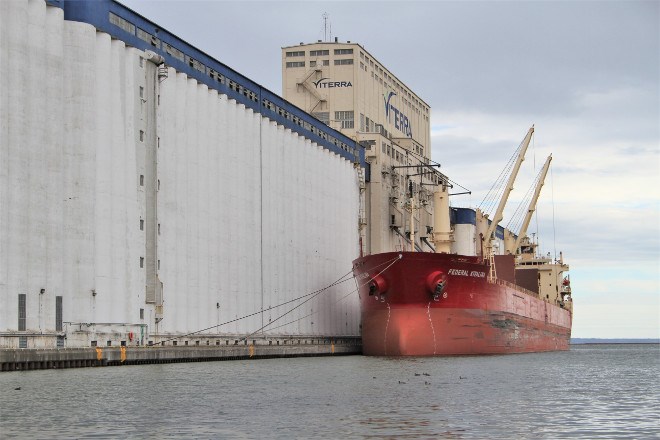Years of advocating for more commerce to come through the Port of Thunder Bay has been paying off, according to Thunder Bay Port Authority CEO Tim Heney, but there is still plenty of room for more.
The latest data shows an upswing in grain and cargo, with demand increasing in South America, Africa and the Middle East, and that is where Heney says they are focusing their efforts to show the world the port is a preferred destination for export and import.
“For project cargo, this year has been one of the best years over the past eight,” he said in an interview. “Grain is still one of our biggest exports, with wheat being the highest, but canola is slowly increasing.”
More local farms have also started to grow and export canola, he added. As well, the port is seeing an increase in lentils as more Canadian farmers grow them.
Many of the changes and increases stem from the elimination of mandatory involvement of the Wheat Board in 2012. Heney explained with the end of the monopoly, farmers had more choice, causing a chain reaction in business. More facilities opened locally, more companies changed hands and companies had fewer costs. The Wheat board is now owned by a conglomerate in Saudi Arabia, which is building facilities in Thunder Bay and Vancouver.
“It made it more competitive and more sustainable into the future,” Heney said. “As well, when the Wheat Board was here boats moved around to different elevators for one load. Now that the grain companies own them, about 93 per cent of them load at only one elevator.”
Another efficiency the port can boast is time spent in port for loads. Thunder Bay’s average is around three days, compared to Vancouver, which is 11.
Despite all of the strides administration has made in marketing, Heney said they are still only at 40 per cent storage capacity. Heney said the appeal of Thunder Bay is the port still has a lot of its original infrastructure in place and ready to go, it just needs users.
“We have storage, loop-around railways, docks,” he said. “We can handle any kind of cargo just as well as other ports like Vancouver. Many companies already have properties along the shipping lanes to the St. Laurence Seaway.”
Heney admitted they are up against tough competition with other markets like the Port of Vancouver, but pointed out their long-term plans for development and cargo projections are decades into the future. Those kinds of projections are difficult to follow, he said, as markets can change dramatically.
“Everyone is looking to Southeast Asia, China, as the leading markets of the future, but no one can really predict 20 years into the future. Anything can happen,” he said. “We are looking at the shorter term to plan ahead, to be ready for sudden changes.
“We are looking at emerging markets in the east. Our data shows they are steadily growing,” he said. “There’s a lot of rhetoric around putting infrastructure in Vancouver, but we have the infrastructure here already. At one point we were the largest grain port in the world. A lot of that capacity is still here.”
In grain alone, he said they could do 20 million tons of grain annually, but currently average around nine million tons, around 40 per cent capacity.
More ships are being utilized for multiple purposes, he said. More are carrying cargo from overseas and dropping it off before picking up grain to bring back to their countries of origin. He pointed to several pieces of components for wind turbines that had been brought over on a ship that was returning to Europe with a shipment of grain, as well as components of a pre-fabricated hotel from India heading west. All of it sitting in Keefer Terminal waiting for pickup.
Even with increases in shipping capacity on both lake and ocean ships, the port can still handle a lot of grain and cargo, he said. The port still boasts several loop tracks that are used for grain, coal and potash offloading, all of which can accommodate up to seven million tons of grain a week, and around 11 million in coal and potash, but are carrying only around a million tons for the same time.
“So we could be using a lot more,” he said.




